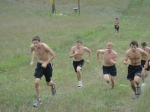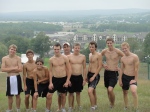It’s easy if you are a coach or an athlete to watch a really experienced high jumper and then of course, try to imitate what you see that athlete doing and apply it to your own jumping style (if you are an athlete who is self-coached or a coach with athletes)
There are many events in track & field, but one of the most consistent errors I witness are novice, or even collegiate athletes who simply don’t have the speed in their approach to run the “J” as wide as a much faster, better jumper does.
Everyone, coaches and athletes alike, see seven foot high jumpers running a 15-18 foot “J” (measuring the number of feet from the standard out where they run the straight portion of their approach) and then they think they can run a 13 to 15 foot “J” on their approach. Too many slower athletes (novice male and female jumpers) and many collegiate, high school and college women make this mistake, and it is really hurting their ability to convert their horizontal speed into vertical lift.
If you want to jump higher, you have to consider tightening your “J” A LOT. If you do tighten your “J” and understand one extra concept that also needs to change (pertaining to your plant) when you tighten your “J”, you will improve your high jump height and your consistency dramatically.
When a 7 foot high jumper runs a curve 17 to 18 feet out from the standards, he needs to do this because he is moving very fast and a curve that is only 7 to 8 feet is simply too tight to allow the athlete enough lean necessary to handle the speed needed to execute a seven foot jump. But a novice or 5’2″ collegiate heptathlete, or even a 5’9″ female high jumper, has to realize she is moving slower than a 7 foot jumper. If these jumpers approach the bar at say 1/3rd or even 1/4 the speed of an elite male jumper, they need to shorten the J curve they run accordingly. When these slower jumpers run a curve that imitates the faster, better jumpers, they put themselves in a terrible position to jump. The wide curve opens them up too much prior to the jump, causing them to slide/travelfor too long down the bar, never converting the little bit of forward momentum they have generated into vertical lift.
In this short article, we are talking about a wide range of athletes, both men and women, and novice, high school and collegiate jumpers. However, the biggest violators are by far the junior high novice jumpers (both boys and girls) the high school jumpers (both boys and girls) and in college (primarily women and men decathletes and heptathletes) Really, the only jumpers that have their “J” approach down are the college men high jumpers and the elite high school men high jumpers.
So here is what the athletes I mentioned above need to do with their approach. Cut your j approach from 12-14 feet that you currently erroneously use and get that measurement down to only 6-8 feet. Yes, 6 feet, I would even consider 8 feet too wide for most women.
The above said, if you do consider tightening your curve there is ONE concept you need to change and that is the way you plant. When you have a more narrow J for an approach, when you plant, you need to have a VERY FAST, VERY QUICK plant that involves turning the your back to the bar VERY aggressively at the same time you plant your left take off foot. (assumes a right side approach in this example) This is also THE EXACT opposite of what you are doing when your “J” approach is too wide. When your approach is too wide, most athletes never turn their backs on the crossbar at the plant, therefore, greatly reducing the lift you get during the plant phase of the jump. Instead, these wide J high jumpers spend their time fixated on watching the crossbar, as they spend forever sliding down the cross bar, looking at the crossbar throughout their entire jump. This is the worst possible thing you can do when you are high jumping, but legions of high jumpers jump like this, and it is, simply…the wrong way to jump. If you are guilty of this style of jumping, you can do SO much better, just by changing a couple of things.
When your “J” is too wide, your shoulders will be perpendicular to the crossbar, with your chest facing the one standard, and your back facing the other. Right after you plant, your chest should be facing the spot you just started your run up from (right after you plant your take off foot) and your back should be beginning to make a complete turn so it is facing the cross bar. I have seen many collegiate women barely expose their backs to the crossbar when they plant, simply because their “J” curve is too wide. If a jumper tightens the curve and adds the aggressive turning of the back to the bar right when they plant their take off foot, it will allow these slower athletes to convert their forward momentum into vertical lift more effectively. ( rather than running a “J” curve that is too wide for the slow speed that they approach the bar)
So, try this tighter curve. And though I am talking primarily to women jumpers here, I am talking to many high school boys and college decathletes when I say, tightening your “J” will greatly improve your personal best in the high jump. I was a 6′ 9″ high jumper as a decathlete. I only had an 8 foot “J” from the right standard, and often, I even pushed the six to seven foot mark for my J approach. Though I had a very fast approach, when I had wider curve, I simply slid down the bar and was unable to convert my forward momentum to vertical lift. Most high school boys could stand to tighten their curve the way I did and I guarantee you will jump higher. Just remember, you have to ALSO turn your back as quick as possible when you plant your take off foot, or this technique will not work.
One last word. If you have had any lower leg injuries of any type from the knee down, don’t attempt a tight turn before being evaluated by your team trainer or medical doctor to decide if you can handle this style of jumping. Stay with the wider turn until it is professionally determined if your injuries in your lower legs and your body can handle the added stress of a tighter J. curve approach.
I hope these ideas work for improving your high jump. Write me if you have any questions.
Thanks,
Gary Bastien

